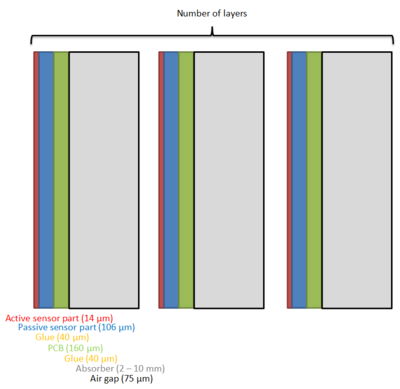DTC optimization
From pCT
Geometry and segmentation optimization of the Digital Tracking Calorimeter
Optimization philosophy
Geometry
Materials
Software
The software for this project is Gate installation and the DTC toolkit. For a complete guide to use the software for optimization, see the page Software for design optimization.
Results
Resolution
All following values are given in units of Water Equivalent Thickness! (Except the absorber thicknesses)
Pre-straggling resolution is the contribution to the total resolution from the detector smearing. This is calculable because we know the range straggling from Monte Carlo simulations, and the pre-straggling resolution is a subtraction in quadrature.
| Material | Thickness | WEPL | Resolution | Excess straggling | Pre-straggling resolution | Layers for 230 MeV + |
|---|---|---|---|---|---|---|
| Al | 2 mm | 1.5 mm | 4.16 mm | 6.1% | 1.38 mm | 67 |
| Al | 3 mm | 2.1 mm | 4.26 mm | 9.2% | 1.69 mm | 48 |
| Al | 4 mm | 2.7 mm | 4.35 mm | 12.4% | 1.97 mm | 39 |
| Al | 5 mm | 3.3 mm | 4.50 mm | 16.4% | 2.28 mm | 32 |
| Al | 6 mm | 3.9 mm | 4.70 mm | 23.3% | 2.73 mm | 27 |
| Al | 7 mm | 4.5 mm | 4.76 mm | 26.0% | 2.78 mm | 23 |
| Loma Linda | N/A | N/A | 6.0 mm* | N/A | N/A | N/A |
| FOCAL | 32 mm | 9.2 mm | 15.6 mm* | N/A | N/A | 11 |
* Resolution scaled to 230 MeV from 200 MeV (Loma Linda) and 188 MeV (FOCAL) (same %, may not be applicable for LL)













